Bucharest - Home of a Medieval Court
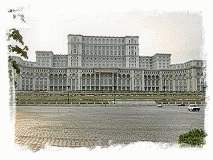 Romania's
capital, the nation's center of cultural and economic life, was
founded 500 years ago and it is a natural starting point for
visiting the country. Any city is what you make of it and Bucharest,
Romania's capital is no exception. Founded officially in 1495 by
Prince Vlad Tepes (also known as Dracula), on the banks of the
Dambovita River, it grew into prominence as the capital of his
court. Vlad Tepes was notorious for his cruelty in impaling his
Turkish enemies, but was equally a wise and brave defender of the
Walachia State he ruled. The name Bucharest derived from the word 'bucur'
(joyful) and, like most European cities, it has had decades of joy,
decades of greatness and decades of grief. When Romania was
recognized as a State in 1862, Bucharest Romania's
capital, the nation's center of cultural and economic life, was
founded 500 years ago and it is a natural starting point for
visiting the country. Any city is what you make of it and Bucharest,
Romania's capital is no exception. Founded officially in 1495 by
Prince Vlad Tepes (also known as Dracula), on the banks of the
Dambovita River, it grew into prominence as the capital of his
court. Vlad Tepes was notorious for his cruelty in impaling his
Turkish enemies, but was equally a wise and brave defender of the
Walachia State he ruled. The name Bucharest derived from the word 'bucur'
(joyful) and, like most European cities, it has had decades of joy,
decades of greatness and decades of grief. When Romania was
recognized as a State in 1862, Bucharest
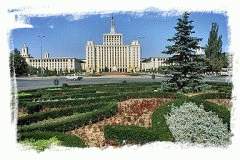 naturally
expanded. After 1918, when Transylvania was reunited with the rest
of the country, the city developed into an acknowledged European
center of culture and good living, earning the name "the Little
Paris of the East". French architects, who had contributed so much
to its style, its tree-lined boulevards and elegant century
architecture in the 19th century, again added grace to its
buildings. After the World War II, the falling of the monarchy and
Communism, so-called "radial" suburbs were built in starkly
utilitarian style to house the workers. In 1977, a devastating
earthquake gave to the dictator Ceausescu the opportunity of
destroying much of the old city and replaces it with the Civic
Centre - a new concept in the architecture of the old town. In spite
of the massive reconstruction of the 1980s, Bucharest remains a
Garden City, leafy and pleasant, with pavement cafes open in the
warm summer, and boating on its lakes and rivers. naturally
expanded. After 1918, when Transylvania was reunited with the rest
of the country, the city developed into an acknowledged European
center of culture and good living, earning the name "the Little
Paris of the East". French architects, who had contributed so much
to its style, its tree-lined boulevards and elegant century
architecture in the 19th century, again added grace to its
buildings. After the World War II, the falling of the monarchy and
Communism, so-called "radial" suburbs were built in starkly
utilitarian style to house the workers. In 1977, a devastating
earthquake gave to the dictator Ceausescu the opportunity of
destroying much of the old city and replaces it with the Civic
Centre - a new concept in the architecture of the old town. In spite
of the massive reconstruction of the 1980s, Bucharest remains a
Garden City, leafy and pleasant, with pavement cafes open in the
warm summer, and boating on its lakes and rivers.
What to See
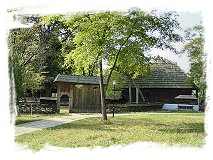 Bucharest's
museums are a visitor attraction already, especially the open air
Village Museum (1936) in the Herastrau Park. Located in the heart of
Bucharest, the museum represents for all Romanians and their foreign
guests a sample of the Romanian spirit, a live image of the
traditional village, a major expression of our natural art. It is an
impressive ethnographic document and of social history. Also, you
should not miss the National History Museum, the National Arts
Museum and the "Grigore Antipa" Natural History Museum. Bucharest's
museums are a visitor attraction already, especially the open air
Village Museum (1936) in the Herastrau Park. Located in the heart of
Bucharest, the museum represents for all Romanians and their foreign
guests a sample of the Romanian spirit, a live image of the
traditional village, a major expression of our natural art. It is an
impressive ethnographic document and of social history. Also, you
should not miss the National History Museum, the National Arts
Museum and the "Grigore Antipa" Natural History Museum.
The buildings representative of the architectural styles of past
centuries include the Coltea Hospital - the first in Bucharest
(1704), Manuc's Inn (1804-1808) - still
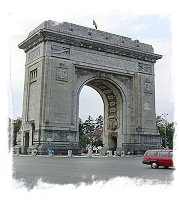 serving
as a popular hotel, Sutu Palace (1833-1834) - in neo-gothic style,
Cotroceni Palace (1893) - currently the Presidential residence,
Catacuzino Palace (1898-1900) - in French baroque style, actually
housing the "George Enescu" Music Museum. serving
as a popular hotel, Sutu Palace (1833-1834) - in neo-gothic style,
Cotroceni Palace (1893) - currently the Presidential residence,
Catacuzino Palace (1898-1900) - in French baroque style, actually
housing the "George Enescu" Music Museum.
Bucharest also contains a surprising number of historic churches:
the Patriarchal Cathedral (1656-1658), Old Court Church (1545-1547),
Cretulescu Church (1720-1722), Stravropoleos Church (1724-1730), and
others.
In 1977 earthquake offered to Nicolae Ceausescu the pretext of
demolishing the historic Spirii Hill district to create his "Civic
Centre", the center piece of which was a building of monumental
proportions - the "House of the People", now the Palace of
Parliament. With a total surface aria of 265,000 sq. m., it is the
biggest in Europe and the second biggest in the world, after the
Pentagon.
A 27 m (88 ft) high Arc of Triumph was erected in 1935 on the
handsome Kiseleff Road, itself longer than the Champs Elysee and
alive with blossom in the spring.
A Garden City Today
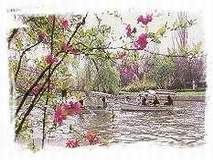 One
of the largest cities in Central and Eastern Europe lies in the
south of the country, on the Romanian Plain. The Colentina River
creates a girdle of lakes - Mogosoaia, Chitila, Baneasa, Herastrau,
Floreasca, Tei and Pantelimon - while the Dambovita River crosses
the city from the west to east, with a huge storage lake at the
entrance, ideal for water sports. One
of the largest cities in Central and Eastern Europe lies in the
south of the country, on the Romanian Plain. The Colentina River
creates a girdle of lakes - Mogosoaia, Chitila, Baneasa, Herastrau,
Floreasca, Tei and Pantelimon - while the Dambovita River crosses
the city from the west to east, with a huge storage lake at the
entrance, ideal for water sports.
A true "green capital" of Europe, Bucharest has many verdant oases,
such as Cismigiu Park (arranged by Viennese architect F. Meyer),
Herastrau Park (on the banks of the lake with the same name, a
pleasant spot for recreation and water sports), Carol Park (1906),
The Botanical Garden (1935) and Tineretului Park.
|
 Romania's
capital, the nation's center of cultural and economic life, was
founded 500 years ago and it is a natural starting point for
visiting the country. Any city is what you make of it and Bucharest,
Romania's capital is no exception. Founded officially in 1495 by
Prince Vlad Tepes (also known as Dracula), on the banks of the
Dambovita River, it grew into prominence as the capital of his
court. Vlad Tepes was notorious for his cruelty in impaling his
Turkish enemies, but was equally a wise and brave defender of the
Walachia State he ruled. The name Bucharest derived from the word 'bucur'
(joyful) and, like most European cities, it has had decades of joy,
decades of greatness and decades of grief. When Romania was
recognized as a State in 1862, Bucharest
Romania's
capital, the nation's center of cultural and economic life, was
founded 500 years ago and it is a natural starting point for
visiting the country. Any city is what you make of it and Bucharest,
Romania's capital is no exception. Founded officially in 1495 by
Prince Vlad Tepes (also known as Dracula), on the banks of the
Dambovita River, it grew into prominence as the capital of his
court. Vlad Tepes was notorious for his cruelty in impaling his
Turkish enemies, but was equally a wise and brave defender of the
Walachia State he ruled. The name Bucharest derived from the word 'bucur'
(joyful) and, like most European cities, it has had decades of joy,
decades of greatness and decades of grief. When Romania was
recognized as a State in 1862, Bucharest
 naturally
expanded. After 1918, when Transylvania was reunited with the rest
of the country, the city developed into an acknowledged European
center of culture and good living, earning the name "the Little
Paris of the East". French architects, who had contributed so much
to its style, its tree-lined boulevards and elegant century
architecture in the 19th century, again added grace to its
buildings. After the World War II, the falling of the monarchy and
Communism, so-called "radial" suburbs were built in starkly
utilitarian style to house the workers. In 1977, a devastating
earthquake gave to the dictator Ceausescu the opportunity of
destroying much of the old city and replaces it with the Civic
Centre - a new concept in the architecture of the old town. In spite
of the massive reconstruction of the 1980s, Bucharest remains a
Garden City, leafy and pleasant, with pavement cafes open in the
warm summer, and boating on its lakes and rivers.
naturally
expanded. After 1918, when Transylvania was reunited with the rest
of the country, the city developed into an acknowledged European
center of culture and good living, earning the name "the Little
Paris of the East". French architects, who had contributed so much
to its style, its tree-lined boulevards and elegant century
architecture in the 19th century, again added grace to its
buildings. After the World War II, the falling of the monarchy and
Communism, so-called "radial" suburbs were built in starkly
utilitarian style to house the workers. In 1977, a devastating
earthquake gave to the dictator Ceausescu the opportunity of
destroying much of the old city and replaces it with the Civic
Centre - a new concept in the architecture of the old town. In spite
of the massive reconstruction of the 1980s, Bucharest remains a
Garden City, leafy and pleasant, with pavement cafes open in the
warm summer, and boating on its lakes and rivers.  Bucharest's
museums are a visitor attraction already, especially the open air
Village Museum (1936) in the Herastrau Park. Located in the heart of
Bucharest, the museum represents for all Romanians and their foreign
guests a sample of the Romanian spirit, a live image of the
traditional village, a major expression of our natural art. It is an
impressive ethnographic document and of social history. Also, you
should not miss the National History Museum, the National Arts
Museum and the "Grigore Antipa" Natural History Museum.
Bucharest's
museums are a visitor attraction already, especially the open air
Village Museum (1936) in the Herastrau Park. Located in the heart of
Bucharest, the museum represents for all Romanians and their foreign
guests a sample of the Romanian spirit, a live image of the
traditional village, a major expression of our natural art. It is an
impressive ethnographic document and of social history. Also, you
should not miss the National History Museum, the National Arts
Museum and the "Grigore Antipa" Natural History Museum.  serving
as a popular hotel, Sutu Palace (1833-1834) - in neo-gothic style,
Cotroceni Palace (1893) - currently the Presidential residence,
Catacuzino Palace (1898-1900) - in French baroque style, actually
housing the "George Enescu" Music Museum.
serving
as a popular hotel, Sutu Palace (1833-1834) - in neo-gothic style,
Cotroceni Palace (1893) - currently the Presidential residence,
Catacuzino Palace (1898-1900) - in French baroque style, actually
housing the "George Enescu" Music Museum.